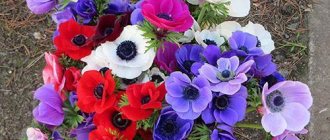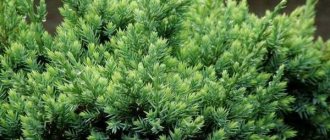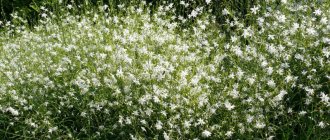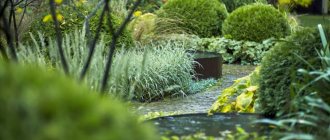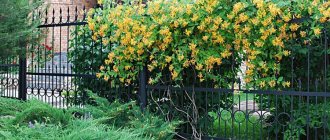Barberry is an ornamental shrub used in landscaping gardens, parks and alleys. Beautiful leaves of different shapes, flowers and fruits have beneficial properties that will give health and vigor to the gardener.
Thanks to the bright color of the leaves and fruits, even a young barberry bush will not get lost in your area
Types of barberry: diversity and attractiveness
There are about 200 species of the plant, each differing in the color of foliage, flowers and fruits, but there is one characteristic feature - spines on the trunk and shoots. The leaves are yellow, green, red; in ornamental crops there is a burgundy color with a silver tint. The flowers of the plant are white, yellow or bright orange, and the fruits are white or red.
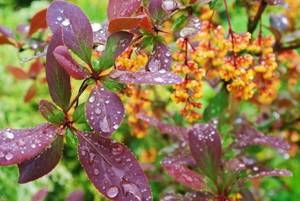
Barberry after the rain

Barberry at the beginning of winter
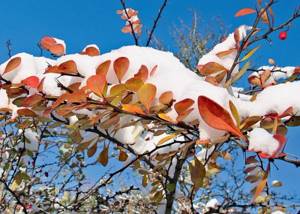
Barberry under a cap of snow
Description of common types:
- Ordinary. 2.5 m high with dark green oblong leaves, blooms in early June with large yellow inflorescences. In autumn, the foliage acquires a heterogeneous yellow color, and the fruits become rich red. The fruits are edible and used in homemade preparations. A species with red, purple leaves is also common.
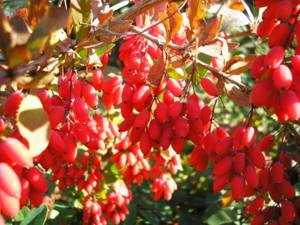
This branched shrub is undemanding to soil and not picky about lighting conditions. - Amursky. A tall bush up to 3.5 m with large green leaves in spring, turning yellow or red in autumn. The red fruits are edible, aromatic and have a sour, refreshing taste.
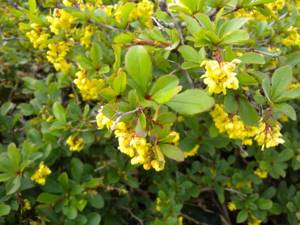
Amur barberry is highly frost-resistant - Tuberga. A bush 1.5 m high with yellow or red leaves and large inflorescences of bright yellow color. The species is decorative and is used in landscape design; the fruits are bitter and not edible.
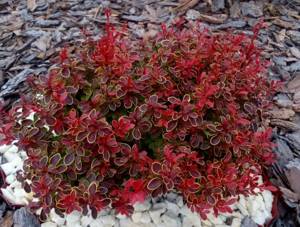
Thunberg's barberry feels great in the polluted environment of a modern metropolis
The variety of colors and decorative dwarf species allows the plant to be used in all types of garden and plot design.

Variety Golden Ring

Variety Atropurpurea
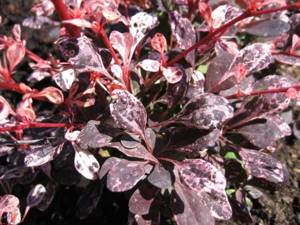
Harlequin variety
Barberries in garden landscape design
It is difficult to imagine that decorative barberry is not used in landscape design. It goes well with other plants, has different colors - you can choose varieties with yellow, burgundy or variegated foliage. The crown of the bush differs in height and shape.
Low-growing species serve as a background for other plants in rockeries, alpine slides, and flower beds. Barberries of medium height with bright leaves are used as a dominant feature when creating garden landscape design. They are placed separately or in group plantings.
During the season, the shades of barberry foliage change, beautiful fruits appear, adding spectacularity and originality to the composition. The berries attract birds, and the area becomes more lively and colorful.
The shrub's ease of care, its rapid growth, and resistance to diseases and pests are additional advantages when designing a landscape with barberry.
What plants are combined with?
Barberry easily combines with any type of plant. It harmonizes with flowering perennials - asters, marigolds, chrysanthemums. Hostas of different colors, petunias, daylilies perfectly set off ornamental shrubs. In contrast to the greenery of coniferous trees, yellow barberries look especially beautiful in the landscape design being created (photo). Situated at the foot of cypresses, thujas, firs, junipers, they make the composition more lively and saturated with light.
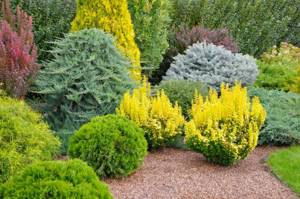
Yellow barberries with erect shoots are especially impressive
Planting ornamental shrubs at the base of tall deciduous trees creates a harmonious backdrop with unusual and ever-changing foliage color. The roses, surrounded by Thunberg's low-growing barberries, look new. Neighborhood with other shrubs - hydrangeas, euonymus, hawthorn, acacia - is quite acceptable.
Planting rules for landscaping
The crop is unpretentious to the soil and tolerates planting well in all ways: propagation by cuttings, layering, dividing the bush and propagated by seeds. Planting is best done in spring or autumn. Dwarf species are planted at a distance of 30 cm; for planting a living fence, 50 cm between bushes is sufficient. It is necessary to add drainage to the trench or hole for planting; barberry does not tolerate high soil moisture and can be affected by fungal diseases.
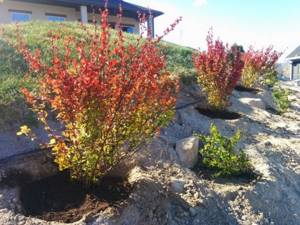
For planting decorative barberries, it is better to choose sunny areas, since in partial shade the varietal qualities begin to be lost and the leaves acquire a greenish tint.
When planting in a hole with barberry, add humus, peat, ash, sprinkle with fertile soil and mulch.
When planting a plant by dividing the bush, it will bloom the next year, when planted by cuttings and layering after 2 years.
Barberry propagation
Barberry propagates quite easily: by dividing the bush, cuttings, root suckers, and seeds.
Seeds
You can collect the seeds and plant them in the ground in the fall.
- We collect only ripe seeds, separate them from the pulp and place them in a weak solution of potassium permanganate or phytosporin for 10 minutes to disinfect them.
- In the fall, we sow the seeds in the shkolka to a depth of approximately 1 - 2 cm, preferably before frost, so that the seeds do not swell from the heat and begin to germinate.
- In the spring the seeds will sprout and will need to be thinned out and mulched.
Water as the top layer of soil dries out. It is better to plant in a semi-shaded place so that there is slight humidity throughout the day.
You can use another method and stratify the seeds . You need to stratify for 2-3 months, outside under the snow or in the refrigerator (not in the freezer), at a temperature of -2 to -5 °C. The plants are kept in the schoolhouse for 2 years and then planted in a permanent place.
Dividing the bush
This is the easiest way. Using a shovel, a part of the root is dug out and transplanted to a new location.
By cuttings
Cuttings 12-15 cm long are cut from May to July. They are planted in a mini-greenhouse under film, in a loose and nutritious substrate. The place for the cuttings should not be sunny; it is best for them to be in the openwork shade of the tree crown.
Horizontal layering
From May to July, the lower shoots are bent down and pinned to the ground or covered with a layer of earth. The ground in the place where the branch was buried should always be moist. It is best to mulch this place.
After about 1.5-2 months, the first roots will appear. Then the branch can be cut off with pruning shears and the new bush that has formed can be planted in another place. You can leave the branch in this position until next spring, then the root system will already be developed and the shoot will quickly grow.
Growing and care
Gardeners new to this crop are wondering: is barberry a tree or shrub and how to care for it. Bush. An unpretentious crop that tolerates drought and cold winters well. If there is insufficient snow cover, the bush may freeze, but the root always survives and sends out new branches in the spring.
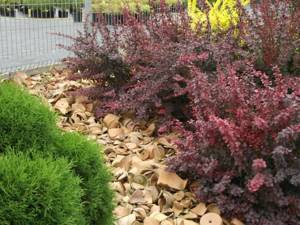
To retain moisture, it is advisable to mulch the soil under barberry with any available material.
The culture is unpretentious in care, which consists of regular pruning, fertilizing and the necessary watering during the dry season.
In rainy summers, it is necessary to loosen the soil under the bush to get rid of excess moisture; in drought, two waterings per week with 4-12 liters of water are sufficient, depending on the growth of the barberry.
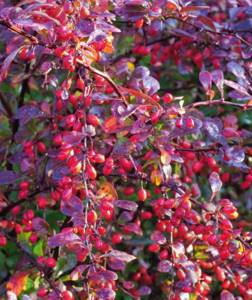
Adult barberry bushes have enough moisture obtained from natural precipitation
For the bright color of the leaves, regular flowering and fruiting, the plant needs sun; in shaded areas the bush develops poorly, rarely blooms and bears fruit poorly.
Plants are fertilized annually in the spring by adding 30-50 grams. urea under the bush.

Urea has the highest nitrogen content, while the element is in an easily digestible form
In early spring, dead branches are cut out and the bush is sprayed against pests with universal compounds.
Planting Barberry Thunberg Bagatelle
You can buy different seedlings in nurseries: up to 8, 20 or 30 cm in height. In this case, the volume of the pot can be from 0.5 to 3 or 5 liters.
- Time. It all depends on the type of seedling. Barberry can be planted in a container from spring to autumn. In this case, the transshipment method is used. A plant with a bare root - only in early spring, when the buds have not yet awakened. In any case, there is no need to deepen the root collar; leave it at ground level.
- Site selection. For barberry Bagatelle, choose the sunniest corners of the yard (it will not die in the shade, but will turn green). The shrub can be planted on a hill - this plant does not like proximity to groundwater. On the contrary, barberry will tolerate a slight drought, but if water stagnates near the roots, the bush will disappear. He is not afraid of the wind.
- Soil selection. Bagatelle is undemanding to the soil. The only thing is that he “likes” the neutral acidity of the soil.
Important! Since Bagatelle grows very slowly, it can only reach those 40x40 cm in the 4th or even 5th year of life. The plant grows only 2-5 cm per year.
Planting a Thunberg bush in a couple of minutes is illustrated here:
Plant care
In early spring the bush is pruned. First, it needs easy shaping. Secondly, sanitary pruning is carried out - broken, dry branches, as well as undeveloped shoots are removed (by the way, such pruning can be carried out both in summer and autumn). Thirdly, old barberry should be rejuvenated (thinning). The plant tolerates any pruning well.
But don't forget about the infrequent thorns that cover the branches of this plant! Wear thick gloves.
There is almost no need to water it. After watering or heavy rain, it is better to weed the tree trunk circle a little, fluffing up the upper part of the soil. Just don’t stick the hoe deep, don’t forget that the roots of the barberry lie high.
Barberry also hardly needs feeding. But you can still use both organic and mineral fertilizers.
- Organic options include rotted manure and compost.
- Of the minerals, give the plant nitrogen in the spring, phosphorus in the summer, and potassium from late summer to early autumn.
In autumn, the area where barberry grows should be mulched.
As for diseases or pests, most owners of this barberry do not encounter them at all.
Wintering the bush
The plant's winter hardiness zone is 4. This means that Bagatelle will overwinter in the region of central Russia (say, in the Moscow region), but all non-lignified branches will freeze. And if the winter turns out to be snowless and frosty, the entire bush will freeze, right down to the root collar.
By the way! But even if the winter is snowy, this is not always good. Under kilograms of snow, this small bush can become wet and dry, or simply become weak and break.
In garden centers it is advised to make a protective shelter for barberry in the fall. And if a lot of snow has fallen, immediately remove part of this natural “blanket”.

Reproduction of this miniature barberry
- Root shoots. The most unreliable way. The fact is that the shoots often “run wild”, without preserving the characteristics of the mother plant. Therefore, it is not worth saving them.
- Layerings. The method is not very troublesome, but also unreliable. In addition, they are simply inconvenient to work with (Bagatel’s branches are too tiny).
- Cuttings. Quite a promising method that allows you to convey to your “children” all the beauty of the mother’s bush. You don’t even have to specially cut branches for cuttings - the shoots remaining after scheduled pruning will do. Ideal if they are summer.
- Dividing the bush. During transplantation, a mature bush (provided that all its parts have characteristic varietal characteristics) can be divided into several parts. Delenki are planted in open ground. They are cared for like an adult barberry.
- Seeds. Barberry seeds have poor germination (40% or lower); seedlings need to be grown for 2 years before planting in open ground. Therefore, it is not customary to grow such a plant from seeds - “the skin is not worth peeling.”
Important! In the first year after planting, the young plant must be looked after especially carefully, watering, feeding and always covering it for the winter. When the barberry blooms, it means that the plant has taken root and you can fuss less with it.
Decorative pruning of a bush
Looking at the photo of a barberry bush, there are different shapes that can be given to the plant. Rapid growth and expansion requires constant pruning of the plant to give it a well-groomed and beautiful appearance.

All barberries require regular pruning, with the exception of low-growing varieties.
It is best to prune excess branches and form the crown in early spring for deciduous varieties and late autumn for evergreen species.
The branched crown of the plant can be given any shape: a circle, a cylinder or a triangle in compositions and a rectangle in a hedge.
The formation of the bush begins in the second year after planting, when the plant gets stronger. During the initial pruning, it is better to limit it to partial formation, and the bush acquires the desired shape in 2-3 years, then it is necessary to trim dead branches and remove grown branches beyond the desired shape.
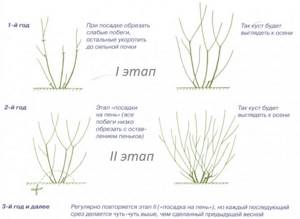
Stages of formative pruning of barberry
Rules for pruning bushes:
- The pruning shears should have a thin, well-sharpened blade so as not to split the twig.
- When pruning, wear protective clothing and gloves; the plant's thorns are sharp and scratches do not heal well.
- The branches are cut at an angle of 45 degrees as close to the bud as possible, then the bush will bloom and bear fruit beautifully and luxuriantly.
- When cutting thick branches, the sections are treated with lime to prevent rotting.
Having planted barberry on the site and given the bush a beautiful shape, the bush will not disappoint and will delight you with the beauty of its flowering and tasty, healthy fruits.
Description of barberry
- A deciduous shrub, its long spines are modified leaves. Only the central dense vein remains from the leaf, and a thorn is obtained. Both the trunk and branches are covered with such thorns.
- It blooms in May with small yellow or orange flowers that completely cover the surface of the bush and emit a delicate aroma, attracting many insects.
- Excellent honey plant. If there are many barberry bushes growing near the apiary, then barberry honey is obtained.
- The fruits come in different colors and are edible and attract birds.
- The highlight of barberries is the beautiful color of the leaves. In the summer it is one color, and in the fall there is just an explosion of colors. For example, in barberries with green foliage, in the fall it becomes bright orange with red splashes, in barberries with yellow foliage, in the fall the yellow color becomes even deeper and more saturated.
- In winter, barberries look very graphic against the background of white snow. Their thin curved branches, decorated with red berries, attract the eye.
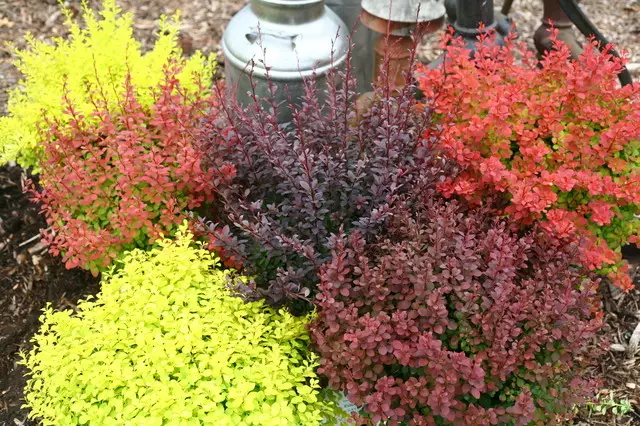
Photo: barberry varieties with different foliage colors
Photo gallery
Photo of a hedge made of garden barberry
Photo of barberry in the garden
Pests and diseases
Barberries rarely suffer from diseases or pests, and the Bagatelle variety is no exception. But sometimes it is affected by the following infections: powdery mildew, bacterial cancer, rust, bacterial necrosis of the bark, leaf spot.
Therefore, in April it is recommended to carry out preventive treatment of Bagatelle barberry bushes with any effective means:
- Bordeaux mixture;

- "Fitoverm";

- "Skor";

- "Maksim";

- "Tattu";
- "Ridomil Gold".
Among the pests, the barberry aphid is the most dangerous. Rarely, moths and barberry sawflies attack bushes. If pests are detected, the plants are immediately treated with insecticides: “Aktellik”, “Aktara”, “Decis”, “Biotlin”, “Iskra”.
Important! Treatment of bushes is carried out in the evening, in dry and windless weather.
What plants does barberry combine with?
Evergreen shrubs are planted in compositions with flowers and trees. Among the crops that coexist with barberry are:
- chrysanthemums, roses, asters;
- coral heuchera, hosta;
- fluffy astilbes;
- low-growing flowers for alpine slides;
- juniper, thuja;
- coniferous trees;
- other flowering shrubs.
When planting a crop along the perimeter of the site, the following “neighbors” are selected:
- wisteria;
- lilac;
- jasmine.
When developing the design of an object, one should take into account the colors of the inflorescences of flowering plants and the leaves of barberry. Marigolds and yellow evergreen shrubs will merge into a continuous spot, as will salvia and the red-leaved variety.
When making a combination of plants, it is important to consider that barberry does not get along well with the following trees:
- poplar;
- nut;
- cherry;
- elder;
- white acacia.
Reviews
There are few reviews of Thunberg’s barberry “Bagatelle” and in general they confirm what was said above:
- Moscow region, outskirts of Klin: “Bagatelle” turned green in the shade of the house and had to be transplanted into a flowerbed;
- Moscow: it grows, every year the young stems freeze and then stick out like antennae, they have to be cut off;
- Belarus, Minsk region: grows in a group with junipers, very beautiful, bright;
- Moscow: we cover it with spandbond every year, there are no problems with freezing.
If you also grew this barberry, please leave your feedback in the comments to the article. It will be useful to other readers.
